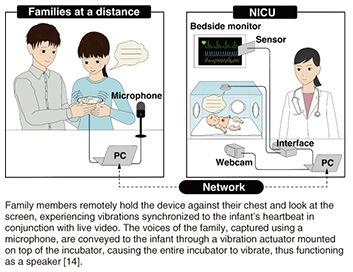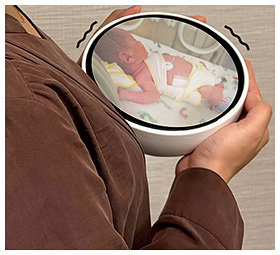 |
|||||||||||||||||||||||||||||||||
|
|
|||||||||||||||||||||||||||||||||
|
Feature Articles: Exploring Humans and Information through the Harmony of Knowledge and Envisioning the Future Vol. 23, No. 10, pp. 56–60, Oct. 2025. https://doi.org/10.53829/ntr202510fa7 From the Study of Embodied Empathy to Supporting Family Wellbeing—Understanding Embodied Empathy and Connecting Distant Families via Bodily Information TransferAbstractEmpathy and bonds between people are essential for maintaining our sense of fulfillment and overall wellbeing. Thus, how are empathy and bonds created? and what kind of information is important to share for deepening empathy and strengthening our bonds? This article focuses on the role of the body in building empathy and bonds, introducing research that explores the mechanisms that play a role in the emergence of empathy. It also introduces attempts to apply bodily interactions in remote communication to strengthen family bonds among those spending time apart. Keywords: empathy, embodied information transfer technology, supporting family bonds 1. The importance of social connection for wellbeingEmpathy and bonds between people are essential for maintaining our sense of fulfillment and overall wellbeing. In their book on how technology can support people’s wellbeing, Calvo and Peters point out that empathy is a key factor in wellbeing [1]. Similarly, the World Health Organization (WHO) defines health in its charter as “a state of complete physical, mental and social wellbeing and not merely the absence of disease or infirmity” [2]. This definition highlights that social connections are essential for human health. Therefore, how are empathy and bonds created? What kind of information is important to share for deepening empathy and strengthening our bonds? This article focuses on the role of the body in building empathy and bonds, introducing research that explores the mechanisms that play a role in the emergence of empathy. It also introduces attempts to apply bodily interactions in remote communication to strengthen family bonds among those spending time apart. 2. The social influence of emotionsEmpathy can be classified into two types: cognitive empathy, which is about understanding others’ emotions, and affective empathy, which is about sharing those emotions. Affective empathy often arises unconsciously when we observe someone’s facial expressions or gestures. For example, seeing someone smile can cause our cheeks to rise unconsciously [3], and watching someone in pain can activate brain regions similar to those engaged when we experience pain [4]. These findings have been revealed through experimental methods in which emotional stimuli—such as facial expressions or signs of pain—are presented to observers, and their emotional responses*1 are measured. In this approach, the flow of information moves unidirectionally from the sender to receiver. In real life, we often experience emotions together with others in various situations. Therefore, empathy is not a one-way process but rather something that involves mutual influence. For example, there are situations that evoke strong emotions, such as festivals, rituals, or watching sports events, and even in everyday settings such as at home or in the workplace, we are likely influenced by each other’s emotions. In such shared experiences—where we observe and respond to one another’s emotional reactions—how do our emotions change? One study reported that when participants immersed their hands in cold water together with a friend—a task known as the Cold Pressor Test—they experienced stronger pain compared with when they performed the task alone [5]. In this study, the researchers compared the subjective intensity of pain between two conditions: performing the task alone and performing it together with another person. The results revealed that subjective pain was significantly higher when the task was done with another person than when it was done alone. This effect only occurred when the partner was a friend; it did not emerge when the partner was a stranger. The finding that shared experiences can amplify subjective pain is highly intriguing; however, the mechanisms underlying this intensified emotional response remain unclear. For instance, does the mere presence of a friend influence the degree of pain experienced? or is it the strength of the friend’s emotional response to their pain that influences one’s own emotions? To address this question, we investigated the mechanisms underlying the amplification of pain. We conducted an experiment in which two participants simultaneously received mild pain stimuli while measuring their emotional responses to the pain. On the basis of previous research [5] showing that emotional amplification is less likely to occur with strangers, we paired students from the same university and provided them with an ice-breaking session to enable them to get acquainted before the experiment. To examine whether emotional responses are intensified simply by being together or through mutually observing each other, we designed two conditions: the participants could see each other’s behavior or a partition was placed between them so they could not observe one another. To assess emotional responses, we measured finger pulse volume (FPV), a physiological marker reflecting sympathetic nervous system activity as part of the autonomic nervous system. Sensors were attached to participants’ fingertips to monitor changes in blood flow. Increases in sympathetic activity lead to peripheral vasoconstriction and reduced blood flow, so we quantified emotional intensity on the basis of FPV amplitude changes, particularly the degree of constriction. Using the recorded FPV as an index, we further conducted analyses to examine how participants were influenced by the emotional responses of their partners. The results revealed that under the condition where participants could see each other, their emotional responses intensified when their partner’s emotional responses were stronger than theirs, whereas no such effect was observed when the partner’s responses were weaker. In contrast, this influence was not observed under the condition where participants could not see each other, suggesting that when experiencing pain together with others, emotional interactions may unconsciously amplify responses to pain [6]. These findings indicate that people are influenced by each other’s emotions when experiencing emotional states.
3. Modulation of affiliation through embodied information transmissionSuch emotional interactions are particularly likely to occur between close partners [5], as they reflect the sense of unity and strength of connection between individuals, and are therefore believed to play a significant role in human relationships [7]. One study reported that physical touch can enhance emotional interactions [8]. In this study, researchers compared conditions under which romantic partners held hands while one of them was experiencing pain versus conditions without hand-holding. They found that holding hands strengthened the synchronization of physiological emotional responses, such as respiration and heart rate. In other words, physical contact with a partner appears to promote unconscious bodily resonance, including physiological linkage. The study also showed that in couples with stronger synchronization of emotional responses, the presence of a partner holding their hand alleviated the perception of pain. These findings suggest that physical touch may enhance bodily resonance and deepen the sense of comfort provided by a partner’s presence. If one could receive information about a partner’s unconscious bodily responses—hereafter referred to as embodied information—through direct physical contact, would this change their sense of connection and affiliation with the partner? Using a device developed by NTT Communication Science Laboratories that simulates the sensation of another person’s heartbeat [9], we designed an experiment where participants were paired with a stranger online. This device reproduces recorded heart sounds via a “heartbeat box” containing a vibration speaker. Participants were assigned to one of two groups: in the first group, they held the heartbeat box with both hands while watching a live video of the partner and felt the vibrations of their heartbeat; in the second group, they only watched the video. Results indicate that participants under the heartbeat condition reported a greater sense of psychological closeness to their partner [10]. 4. Applications for remote family communicationOn the basis of previous experimental evidence that transmitting embodied information as tactile vibrations can contribute to strengthening feelings of affiliation, we have launched a collaborative research project with Iwate Medical University to apply this technology to simulate heartbeat vibrations and support remote communication between physically separated family members. Japan is recognized as having one of the highest standards of perinatal care among developed countries. Infants born before 28 weeks of gestation—referred to as extremely preterm infants*2—have the highest survival rates in the world in Japan [11]. Babies born prematurely or with low birth weight are typically admitted to neonatal intensive care units (NICUs), where they may require prolonged hospitalizations lasting several months. Such extended stays can limit opportunities for parent–infant physical contact, which has been reported to impact parental mental health and the development of parent–child attachment [12]. To address this, NICUs actively promote practices such as kangaroo care—holding the baby skin-to-skin against the parent’s chest—to support parent–infant bonding even during hospitalization. However, opportunities for in-person visits are sometimes restricted due to measures against high-risk emerging infectious diseases such as COVID-19, as well as practical constraints such as parents’ time limitations (e.g., work or caring for older children) and geographical barriers (e.g., difficulty accessing the hospital). In response to visitation restrictions during the COVID-19 pandemic, many NICUs, including Iwate Medical University Hospital, introduced online visitation systems. Since then, these systems have continued to be used by families who are unable to visit in person frequently due to various circumstances, serving as a supplement to face-to-face visits. Online visitation offers advantages such as enabling siblings and grandparents of the baby to join easily and simultaneously. It is also expected to help alleviate parental anxiety by enabling parents to see their baby and their surroundings. However, it has also been pointed out that some parents experience conflicting emotions—such as a sense of longing from being able to see but not touch their baby and feelings of guilt about not being able to comfort their crying baby [13]. To address this issue, we designed the Embodied Online Visitation System that enables the transmission of family voices to the infant and the delivery of the infant’s embodied information to distant family members. Through this system, family members hold a device against their chest and experience synchronized heartbeat vibrations in real time—matched to the baby’s heartbeats inside the incubator—alongside live video. At the same time, the family’s voices are captured with a microphone and transmitted through a vibration actuator mounted on the incubator, enabling their voices to reach the baby (Figs. 1 and 2) [14]. When a parent speaks to the baby, the audio captured with the microphone is sent over the network to the vibration actuator attached to the incubator frame. By using the vibration actuator, the incubator functions as a speaker, enabling the baby to perceive the family’s voices without the need for placing a speaker inside the incubator. Regarding the baby’s heartbeat, directly acquiring heart sounds would require attaching a stethoscope-type microphone to the baby, raising concerns about placing an additional burden on the infant. To address this, we adopted an approach in which real-time heartbeat information—derived from the electrocardiogram displayed on the bedside monitor—is acquired and used to synchronize a model heartbeat sound, which is reproduced using a vibration speaker embedded in the device, enabling family members to experience the tactile sensation of the baby’s actual heartbeat rhythm (thump-thump) in real time. Importantly, the model heartbeat sound is not artificially generated; instead, it is created from recordings of actual neonatal heart sounds obtained using a stethoscope-type microphone. The device is also equipped with a display that shows a live video feed of the baby, captured using a webcam, so that the visual of the baby is delivered simultaneously with the heartbeat vibrations. We conducted a survey with families of extremely preterm infants hospitalized in the NICU and found that many participants felt a stronger sense of their baby’s presence when using the Embodied Online Visitation System, compared with conventional online visitation, which only enables viewing the baby on a computer screen. In interviews, participants shared comments such as, “I could feel as if I were holding my baby through both visual and tactile sensations,” and “Feeling the heartbeat gave me the sense of holding my baby in my arms, which eased my loneliness.” These findings suggest that, even from a distance, the system may help foster parent–infant bonding and attachment through mediated physical interaction [14].
References
|
|||||||||||||||||||||||||||||||||











